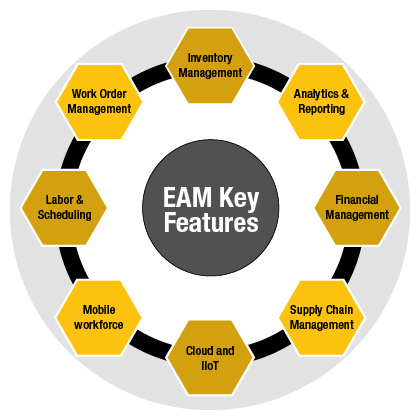What are Enterprise Asset Management Systems?
 Enterprise asset management (EAM) systems offer a strategy to effectively maintain and manage all an organization’s assets and equipment throughout their entire lifecycles – -from procurement to retirement. In addition, EAM systems help teams manage the supply chain, spare parts inventory, and shipment arrival dates to keep production and maintenance schedules running as efficiently as possible. EAM typically refers not to just one software, but to a strategy that combines multiple software, systems, and solutions that work together to provide a comprehensive approach to asset management.
Enterprise asset management (EAM) systems offer a strategy to effectively maintain and manage all an organization’s assets and equipment throughout their entire lifecycles – -from procurement to retirement. In addition, EAM systems help teams manage the supply chain, spare parts inventory, and shipment arrival dates to keep production and maintenance schedules running as efficiently as possible. EAM typically refers not to just one software, but to a strategy that combines multiple software, systems, and solutions that work together to provide a comprehensive approach to asset management.
An EAM system is a major step up from manual asset and facilities management approaches. Instead of using manual error-prone spreadsheets to keep track of all of your assets and related activities, an EAM system continuously captures this information in a centralized digital location.
EAM exemplifies the act of collecting data from all the interlocking operations taking place inside a plant. Everything is documented and accessed in one place: registering equipment, assigning maintenance tasks, budgeting expenses, documenting processes, and other essential functions.
In the meantime, an enterprise asset management system supports overall equipment effectiveness by flagging poor-performing assets and using sensors to increase the precision of data so you can respond proactively to calls for repairs before they lead to failure and unplanned downtime. Simply put, an EAM system enables best practices for ensuring asset availability, reliability, and longevity.
The Difference Between EAM, CMMS, and ERP Systems
Enterprise asset management is an asset lifecycle strategy. Computerized maintenance management system (CMMS) software is a tool that centralizes and optimizes the information integral to EAM.
CMMS is a software solution that automates tasks, streamlines processes, and increases communication and transparency. CMMS software helps maintenance teams effectively manage assets from machinery to fleets to facilities. A CMMS is specifically responsible for overseeing equipment already in use and the maintenance required during its run cycle. Most of the tracking occurs by the way of work orders and scheduled repairs or replacements, with some reports thrown in here and there.
Enterprise resource management, or ERP, is the practice of integrating and organizing business data in one centralized system. An ERP software covers core organizational functions such as production, inventory, sales, accounting, and more. The visibility that comes from centrally collected, managed, and shared data can drive efficiency and improve the decision-making process.
Enterprise asset management encompasses many of the same core functions as a CMMS software and an ERP software, but EAM refers to the overall strategy and systems used to execute these capabilities throughout the entire lifecycles of your assets.
Who Uses Enterprise Asset Management Systems?
Enterprise Asset Management Systems are the backbone of many manufacturing operations across a wide variety of industries, including but not limited to:
- Oil & Gas: An EAM system helps keep assets in optimal working condition to ensure a safe, productive, and efficient oil & gas operations.
- Food & Beverage: An EAM solution can help prepare food & beverage facilities for FDA audits, make meeting compliance standards simpler, and decrease budgetary burdens.
- Automotive Manufacturing: Implementing an EAM can help standardize operations across production lines and facilities and meet strict International Automotive Task Force (IATF) regulations.
- Fleet Maintenance: Leverage an EAM to manage fleet asset repair and maintenance, while also tracking key metrics such as total cost of ownership (TCO).
- Healthcare: An EAM strategy streamlines and digitizes recordkeeping, which helps teams keep healthcare facilities safe and healthy, meet compliance regulations, and more easily pass audits.
Get the Most Value out of Enterprise Asset Management Systems
To keep up with the Industrial Internet of Things (IIoT), organizations should be sure to include connected reliability principles in their enterprise asset management strategies. Connected data, systems, and teams allow for advanced analytics, increased communication, and expansion of IIoT initiatives. When teams make data-driven maintenance and management decisions, they improve asset efficiency and performance. This transforms maintenance into a business value driver.
eMaint is both a CMMS and EAM software that offers robust work and asset management tools. Learn more about CMMS.

